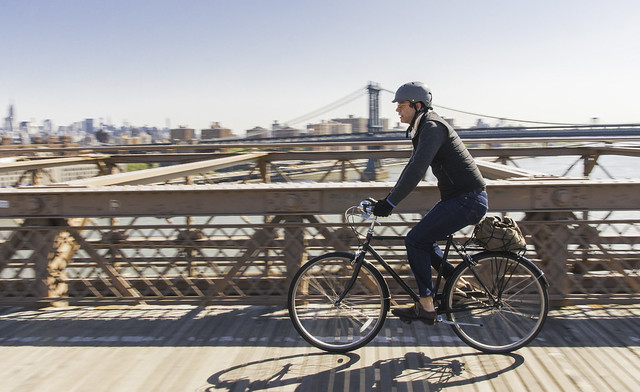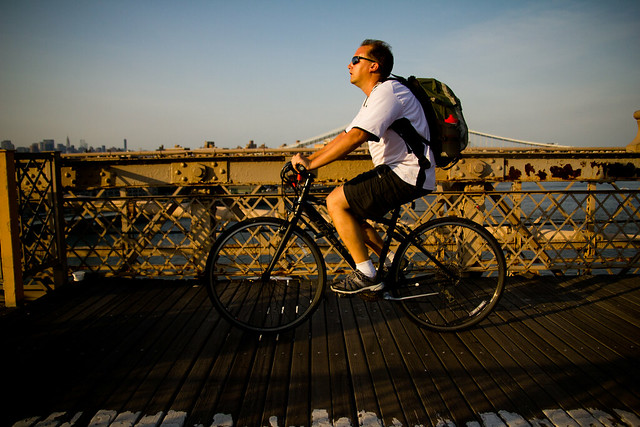Related Posts:
> See the "access and urban freedom" category of this blog.
Details:
1. In many cities it's getting harder for many people to sustain, well-paid employment that continually improves their quality of life
- Sustained, well-paid employment is becoming rarer in most cities so job access and targeting the most appropriate opportunities is much more critical than it used to be - thoughtful, informed choices are needed about where to live, what to study and what kind of jobs to pursue. The Regional Plan Association highlights this broader change for the New York Tri-State area in the illustration below.
"Many of the industries that have seen the greatest gains in number of employees pay the lowest wages. Higher-paid jobs tend to be in industries that are declining in employment."
RPA: Opportunities are limited for too many people
2. Different city locations are typically very inequal in terms of efficient, affordable job access
- It isn't surprising that jobs are concentrated in specific areas in cities (e.g. downtown) and that there might be certain pockets of greater access scattered around for different industries. However, specific information on the best cost-equivalent locations for access to jobs suitable to your skills and interests takes conscientious effort to discover. If you don't have very reliable, well-paid employment this information should influence where you choose to live, especially if buying a house and your options for moving later may be constrained.
- Below you can see the job density for the "Information Services" job category on the Regional Plan Association map:
- While it's unlikely you'll find the perfect map for your own city and relevant industry, there should be sufficient information available on job opportunities by location to provide some guidance as to how to optimise your job access. The interesting examples in the high-quality maps for other cities will also inform you as to potential opportunities and pitfalls. Public transport variations are particularly significant - you can't just assume that similar distances equal similar commute times.
"How long it really takes to reach specific transit points from the ’burbs. A 70-minute commute by public transit from the town of Paramus opens up much of northern New Jersey but just a small pocket in the area around Penn Station."
Next City: The Power of Mapping Tri-State Jobs by Commute
- In Australia, the Grattan Institute found that:
Many workers, particularly in outer suburbs, only have access to a small proportion of jobs across the city. In some outer suburban growth areas of Melbourne just 10 per cent of Melbourne’s jobs can be reached within a 45 minute drive (lightest shaded areas).Grattan Institute: Mapping Australia’s economy: cities as engines of prosperity (pdf)
Grattan Institute: Mapping Australia’s economy: cities as engines of prosperity (pdf)
3. Your housing and transport choices should be guided by commuting analysis
- There's no point moving a bit further out into the suburbs - to save money on buying or renting a house - if it eliminates an acceptable commute to a desirable job or dense pockets of potential ones. Similarly, while you may prefer to live closer to family, friends, where you grew up or certain neighbourhoods, these preferences may need to take a back seat to your commuting access to desirable jobs.
- Accurate travel-time maps for your commute by the various modes actually available to you (car parking in prime destinations may be prohibitively costly) is a great help in informing such decisions. Even without accurate maps you can do this measurement yourself - via public transport, car and, where feasible, cycling or walking.
- Below the Regional Plan Association "Access to jobs" map allows you to drop a pin in different housing locations, select job industries, select a maximum commute time and then switch between different transport modes to see the extent of your job access.
- For public transport, the 30min job access area in peak hour from Clinton Hill in Brooklyn is as below. Naturally the train and subway lines extend the access area corridors the furthest.
For cycling, the potential access area is much wider and more even in all directions. Though you'd need to do further investigation as to the most bike-friendly and pleasant routes - which is likely to be a big factor in whether you actually would cycle or not. Google Maps' bicycling layer would be a useful tool to use in conjunction with this. See: Choose where to live with cycling and your commute in mind
For driving, the 30min area is easily the largest but your actual gains in job access or commuting benefits are what matter. If working in Information Services on Manhattan then driving isn't likely to be a feasible and affordable commuting option. However, if your employment is often based outside of the denser, congested areas of cities then being on the right side of cities with convenient arterial road access is clearly advantageous.
RPA: Access to jobs map
4. Areas with deficient public transport service but access to good cycling commuter routes can provide affordable living
- The affordability of housing is the biggest factor in people's decisions on where to live and their ability to live in an area that provides the greatest opportunities (e.g. good public schools) and highest quality of life. Unfortunately, the cost of housing keeps on outpacing the increase in average incomes in all desirable city locations.
RPA: The rising cost of living threatens our prosperity and quality of life
- However, those willing to cycle for transport in cities where most aren't are able to capitalise on that fact by paying much less to buy or rent housing in areas with poor or sub-optimal public transport to work and where there are few feasible alternatives (e.g. driving).
RPA: The rising cost of living threatens our prosperity and quality of life
- However, those willing to cycle for transport in cities where most aren't are able to capitalise on that fact by paying much less to buy or rent housing in areas with poor or sub-optimal public transport to work and where there are few feasible alternatives (e.g. driving).
- In New York many residents work in Manhattan and public transport is the only feasible option for most, apart from cycling. Yet cycling for transport isn't something that most Americans are willing to do or feel capable of. Those that are best placed to rely on cycling are uniquely positioned to save massively on the costs of buying or renting housing as they can pick areas with public transport deficiencies which have no price premium.
"People get so much more for their money in this tight, compressed market,” when freed from the need to be near a train line, he said. “Your definable boundaries are different on a bike.” Without one, he said, “your map changes.”- The New York Times article profiles Jesse Warner-Levine and Hallie Nickelson from Wallabout "a fairly isolated Brooklyn neighborhood on the fringe of Clinton Hill near the Brooklyn Navy Yard."
NY Times: No MetroCard Needed - Bikes Change Your Brooklyn Apartment Hunt
"The two-bedroom one-bath walk-up they moved into three years ago for $1,800 a month had windows on three sides and was cheaper and more charming than previous apartments they had shared with roommates in other parts of Brooklyn. Yet the closest subway line — the G, which requires a transfer to get to Manhattan — was half a mile away and erratic, turning what should have been a 25-minute commute into 45 minutes or more, depending on when the train showed up. As an alternative, they turned to their bikes, heaving them up and down three flights of stairs each day in exchange for a faster, more reliable commute."- Importantly, it is access to safe-enough, convenient bike routes that is the key factor facilitating a sustained switch to commuting by bike:
"By zipping along Flushing Avenue’s bike lanes and across the Manhattan Bridge, Mr. Warner-Levine, a retail wine salesman, found he could make it to his job in Lower Manhattan in 18 minutes flat."The Flushing Ave separated bike lane that facilitates commuting by bike
5. Using cycling to close the public transport gaps is a viable solution, you don't need to cycle the whole way
- It's not necessary to cycle the whole way to your job, though you may eventually work your way up to it. The key may just be in shaving off the inconvenient transit connection or very long walk that makes depending wholly on public transport undesirable:
- It's not necessary to cycle the whole way to your job, though you may eventually work your way up to it. The key may just be in shaving off the inconvenient transit connection or very long walk that makes depending wholly on public transport undesirable:
"Last month, Dana Johns, a physician assistant, doubled her living space and cut her rent by 20 percent by moving from a two-bedroom in the East Village she shared with a roommate to a two-bedroom, two-bath she also shares at 110 Green Street, a luxury rental building in Greenpoint, Brooklyn, that advertises “bike storage” and “bike-friendly streets” on its website. Ms. Johns has a Bianchi Pista and a Brompton folding bike she stores indoors, but to ease her commute, she bought a vintage ocean coaster at a flea market in Bushwick for $75. The two locks she uses to tie it up on the street, she said, cost more.
Now, instead of “waiting forever for the G” and transferring in Queens to the E to get to her office on 48th Street in Manhattan, she said, “I take my beater bike in the morning across the Pulaski Bridge and park it at the 7.” By hopping the train one stop to Grand Central, she said, she avoids showing up to work sweaty. With the weather getting nicer, she added, “I’m working toward biking over the Queensboro Bridge to go direct to work.”
NY Times: No MetroCard Needed - Bikes Change Your Brooklyn Apartment Hunt

CC by 2.0: Flickr - Tiago
6. Efficient access to public transport is still desirable so don't totally eliminate it in seeking affordability
- The greatest advantages in affordability, health and quality of life come from not being car dependent and still having effective transport to your desired destinations. Cycling all year round to work (including winter) or for all trips or at all times of the day isn't convenient or desirable for most people. Hence, a certain level of public transport access is still desirable, it's just that the lower the level you need the more affordable your housing can be.
- Remember that the housing price premium people place on public transport is not just distance but also service convenience (directness, frequency) and comfort. By cycling to work most of the year you may be able to save money by living in areas which aren't too far from public transport but where the service isn't very convenient (indirect, infrequent). If public transport (plus walking) is only your fallback commuting option then you can likely live with this occasional inconvenience better than most.
- The below map by the Sydney Alliance illustrates how service frequency varies significantly across a city. It's possible to find many desirable city locations that aren't too far from public transport but don't have frequent service - this is a perfect situation for commuter cyclists seeking affordable housing.
Sydney Alliance - Public transport access map
Further Info:















